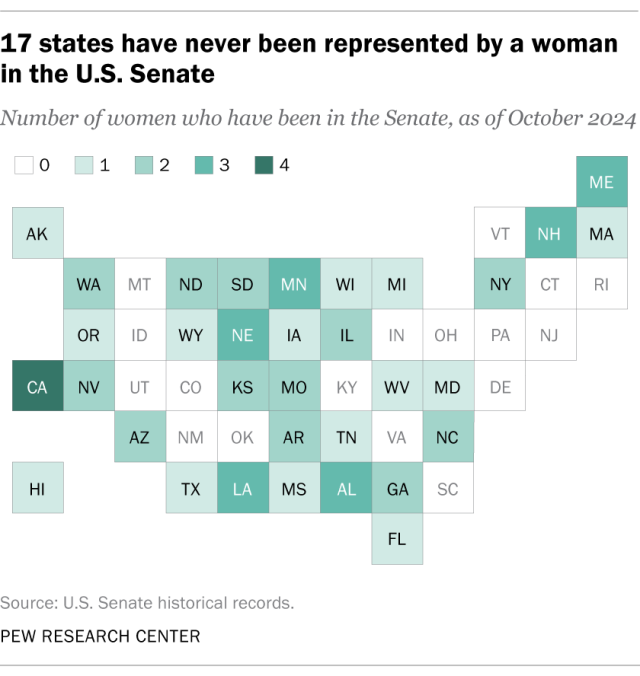If Kamala Harris wins the presidency this November, she will be the first woman ever elected to the highest political office of the United States.
There could also be similar firsts in political contests around the country: Five races for U.S. Senate and two for governor feature a major-party nominee who, if elected, would be the first woman in their state to hold the office. And in Minnesota, a woman will ascend to the governorship for the first time if current Gov. Tim Walz is elected as Harris’ vice president.
If elected, Democratic presidential nominee Kamala Harris would be the first woman in the top political office in the United States. We conducted this analysis to determine how many Senate and governor’s races could result in similar firsts.
For this analysis, we used data from U.S. Senate historical records, the Rutgers University Center for American Women and Politics and recent news reports.

Overall, 17 states have never had a female senator, according to a Pew Research Center analysis of Senate historical records. This fall, Senate races in Delaware, Indiana, New Mexico, Rhode Island and Utah each feature a woman nominee who could become the state’s first.
Three of these candidates (Lisa Blunt Rochester of Delaware, Valerie McCray of Indiana and Caroline Gleich of Utah) are Democrats, and two (Nella Domenici of New Mexico and Patricia Morgan of Rhode Island) are Republicans.
Blunt Rochester and McCray would also be the first Black senators to represent their respective states.

Among the 18 states that have never had a woman governor, two – Indiana and Missouri – have a woman on the ballot in this year’s general election. Jennifer McCormick of Indiana and Crystal Quade of Missouri are both Democratic nominees.
And in Minnesota, Lt. Gov. Peggy Flanagan will take over as governor if Walz is elected vice president. That would make her the first woman and the first Native American person to hold the office.
Five states have not had a woman senator or a woman governor: Colorado, Idaho, Indiana, Pennsylvania and Virginia.
Women have served in numerous statewide executive and legislative offices over the decades, including in all the states where they have not yet held Senate seats or governorships. And every state has sent at least one woman to either the U.S. House of Representatives or the Senate.
Women in the 118th Senate
In the current Congress, women hold 25 of 100 Senate seats – a record high. They represent a total of 21 states. In Minnesota, Nevada, New Hampshire and Washington, both senators are women.
Fourteen of the 25 current senators are the first women to represent their state in the Senate. Their tenures vary: Washington Democrat Patty Murray has served in the Senate since 1993, whereas Wyoming Republican Cynthia Lummis took office in 2021.
Fifteen current women senators are Democrats, nine are Republicans and one (Kyrsten Sinema of Arizona) is an independent. Looking at the Senate as a whole, women make up a larger share of the Democratic caucus (31%) than the Republican caucus (18%).
A century in the Senate
Women have served in the Senate for over a century. In 1922, Rebecca Latimer Felton, a suffragist from Georgia, became the first woman senator. She was appointed to a vacant seat and served for just one day.

Since then, a total of 60 women have represented 33 states in the Senate, and most of them have served in recent decades. About three-quarters (46) first took office after 1980.
A little over half (19) of the states that have ever been represented by a woman in the Senate have sent more than one.
Four women have represented California in the Senate, the most from any state. In addition to Harris, who represented the state from 2017 to 2021, this group includes two long-serving senators. Democrat Dianne Feinstein took office in 1992 and served until her death in 2023, and Barbara Boxer, also a Democrat, was in office from 1993 to 2017.
Alabama, Louisiana, Maine, Minnesota, Nebraska and New Hampshire have each sent three women to the Senate.
Related: 22 states have ever elected a Black woman to Congress
Women in the governor’s mansion

Overall, 49 women have held the governorship in 32 states since 1925, when two women took the oath of office for the first time.
That year, Nellie Tayloe Ross of Wyoming was nominated in a special election and won the governorship following the death of her husband, Gov. William Ross. Miriam “Ma” Ferguson of Texas, the first woman ever chosen for the office in a general election, was sworn in just 15 days later.
Women currently serve as governors in 12 states. Eight are Democrats and four are Republicans.
Five of the current governors are the first women elected in their state: Democrats Janet Mills of Maine and Kathy Hochul of New York; and Republicans Kim Reynolds of Iowa, Kristi Noem of South Dakota and Sarah Huckabee Sanders of Arkansas.
In Arizona, five women have held the governorship since 1988 – by far the most from any state. In fact, three women served consecutively over a 17-year stretch, from Republican Jane Hull’s ascension in 1997 until Republican Jan Brewer left office in 2015.
CORRECTION (Nov. 1, 2024): This analysis has been updated to indicate that every state has been represented by a woman in either the U.S. House of Representatives or the U.S. Senate.
